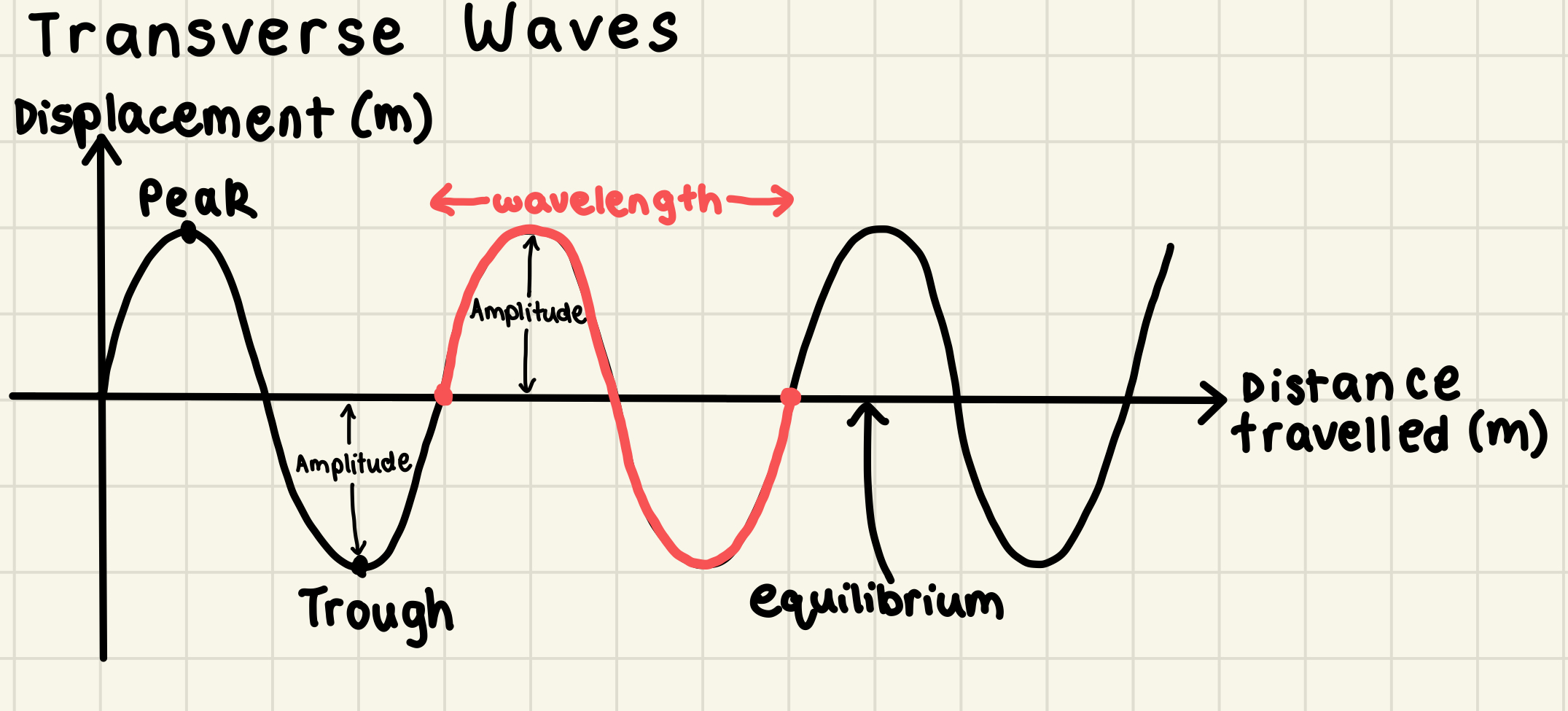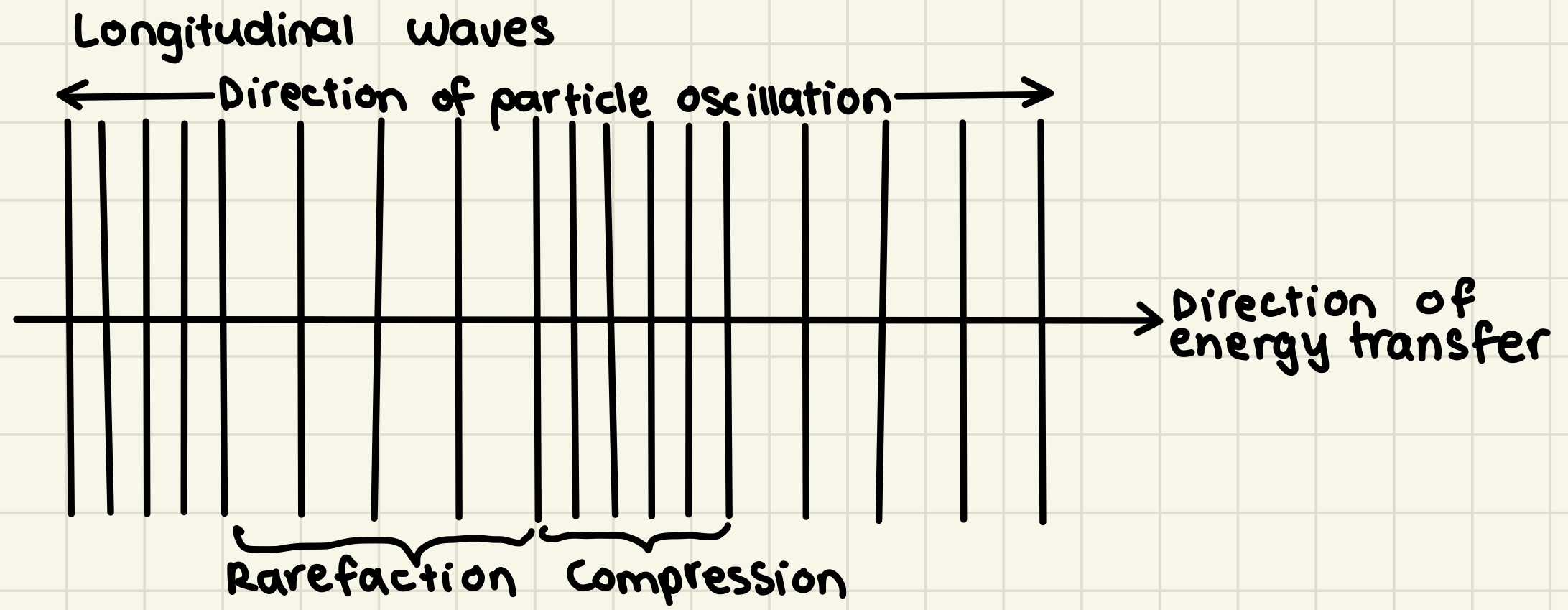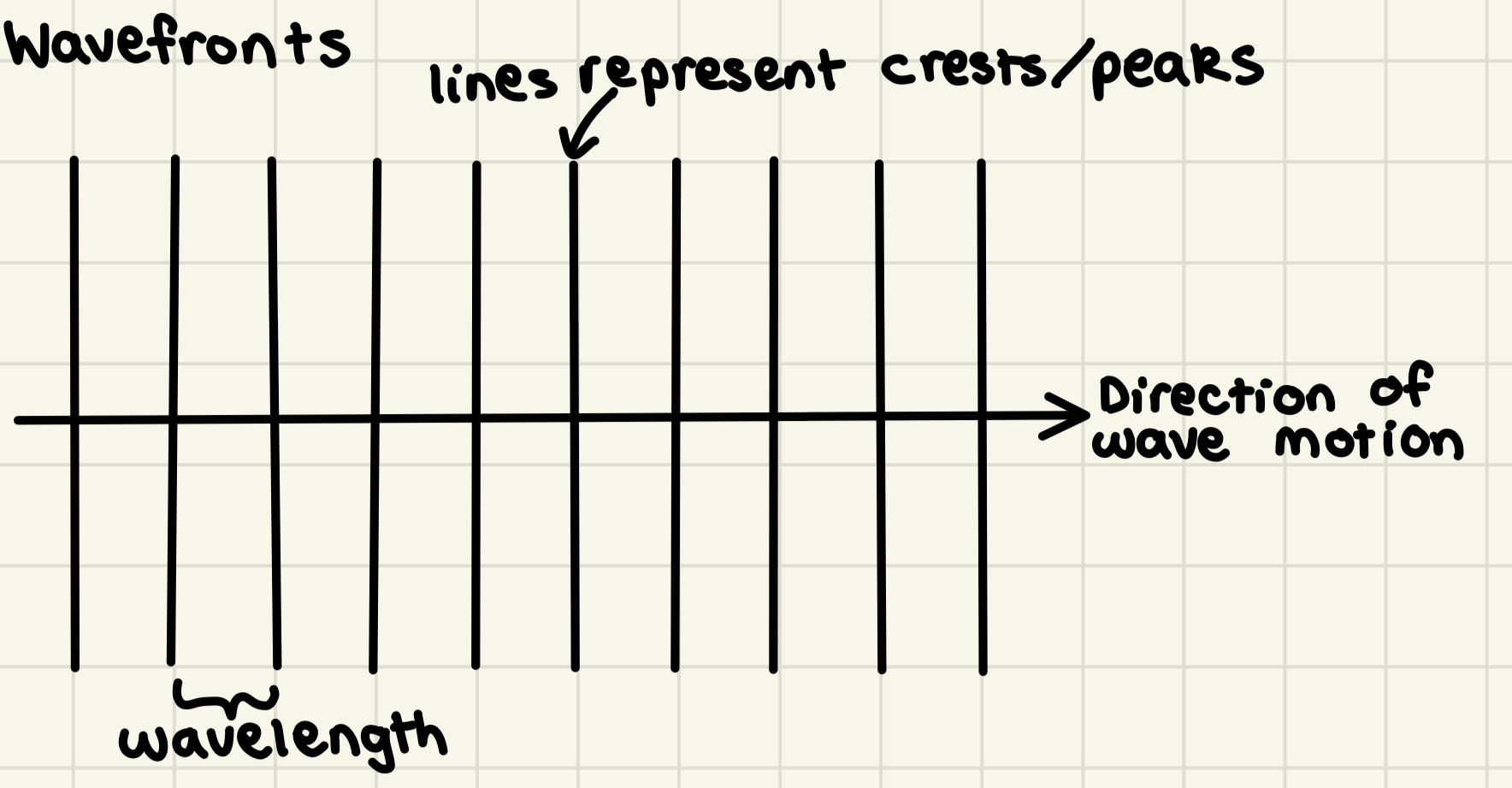3.01-3.07 Longitudinal/Transverse Waves + Wave Speed + Frequency
5.0(1)
5.0(1)
Card Sorting
1/28
Earn XP
Description and Tags
Study Analytics
Name | Mastery | Learn | Test | Matching | Spaced |
|---|
No study sessions yet.
29 Terms
1
New cards
Degree (°)
Unit for measuring angles
2
New cards
Hertz (Hz)
Unit for measuring frequency
1 Hz = 1 complete cycle per second
1 Hz = 1 complete cycle per second
3
New cards
Meter (m)
Unit for measuring length
4
New cards
Meter/second (m/s)
Unit for measuring speed and/or velocity
5
New cards
Second (s)
Unit for measuring time
6
New cards
Wave
Vibrations that transfer energy and information without transferring matter
7
New cards
Oscillation
Vibration; repeated back-and-forth movement between any 2 states and/or positions of an object due to its displacement from its equilibrium
8
New cards
Transverse wave
Waves that vibrate or oscillate perpendicular to the direction of energy transfer
* Particle oscillations ⟂ to energy transfer’s direction
* Energy transferred in same direction as wave motion
* Energy transferred but particles of the medium are not
* Particles of the medium are not displaced and not transferred (although they move, they are not displaced because the particles move back and forth along the same axis/line so always return to their original position → hence the displacement of 0)
* Waves can move in solids and on the surface of liquids, but cannot move inside liquids or gases
* Some transverse waves (e.g. electromagnetic waves) can move in solids, liquids, gases, and vacuum
* Particle oscillations ⟂ to energy transfer’s direction
* Energy transferred in same direction as wave motion
* Energy transferred but particles of the medium are not
* Particles of the medium are not displaced and not transferred (although they move, they are not displaced because the particles move back and forth along the same axis/line so always return to their original position → hence the displacement of 0)
* Waves can move in solids and on the surface of liquids, but cannot move inside liquids or gases
* Some transverse waves (e.g. electromagnetic waves) can move in solids, liquids, gases, and vacuum

9
New cards
Examples of transverse waves
* Light waves
* Electromagnetic waves (e.g. radio, light, X-rays)
* Ripples on surface water
* Vibrations on guitar string (or vibrations on any string instrument)
* Electromagnetic waves (e.g. radio, light, X-rays)
* Ripples on surface water
* Vibrations on guitar string (or vibrations on any string instrument)
10
New cards
Longitudinal wave
Waves where the points along its length vibrate parallel to the direction of energy transfer
* Particle oscillations are // to energy transfer’s direction
* Energy transferred in same direction as wave motion
* Energy transferred but particles of the medium are not
* Particles of the medium are not displaced and not transferred because the particles move back and forth along the same axis so always return to their original position → hence the displacement of 0)
* Can move in solids, liquids, and gases
* Cannot move in vacuum because there are no particles
* Particle oscillations are // to energy transfer’s direction
* Energy transferred in same direction as wave motion
* Energy transferred but particles of the medium are not
* Particles of the medium are not displaced and not transferred because the particles move back and forth along the same axis so always return to their original position → hence the displacement of 0)
* Can move in solids, liquids, and gases
* Cannot move in vacuum because there are no particles
11
New cards
Examples of longitudinal waves
* Sound waves
* Pressure waves caused by repeated movements in a fluid (liquid or gas)
* Shockwaves (e.g. some seismic waves)
* Pressure waves caused by repeated movements in a fluid (liquid or gas)
* Shockwaves (e.g. some seismic waves)
12
New cards
Seismic wave
Waves that travel through or over Earth and which are generated by movement of the Earth’s tectonic plates
13
New cards
Transverse wave VS longitudinal wave
* Structure
* Transverse → peaks/crests and troughs
* Longitudinal → rarefactions and compressions
* Vibration
* Transverse → ⟂ to energy transfer’s direction
* Longitudinal → // to energy transfer’s direction
* Vacuum
* Transverse → only electromagnetic waves can travel through vacuum
* Longitudinal → cannot travel through vacuum
* Medium
* Transverse → can move in solids and on the surface of liquids, but not inside liquids or gases
* Longitudinal → can move in solids, liquids, and gases
* Density
* Transverse → constant density
* Longitudinal → changing density
* Pressure
* Transverse → constant pressure
* Longitudinal → changing pressure
* Wave speed
* Transverse → dependent on medium
* Longitudinal → dependent on medium
* Transverse → peaks/crests and troughs
* Longitudinal → rarefactions and compressions
* Vibration
* Transverse → ⟂ to energy transfer’s direction
* Longitudinal → // to energy transfer’s direction
* Vacuum
* Transverse → only electromagnetic waves can travel through vacuum
* Longitudinal → cannot travel through vacuum
* Medium
* Transverse → can move in solids and on the surface of liquids, but not inside liquids or gases
* Longitudinal → can move in solids, liquids, and gases
* Density
* Transverse → constant density
* Longitudinal → changing density
* Pressure
* Transverse → constant pressure
* Longitudinal → changing pressure
* Wave speed
* Transverse → dependent on medium
* Longitudinal → dependent on medium
14
New cards
How are longitudinal waves drawn/represented?
Drawn as a set of vertical lines with rarefactions and compressions. Direction of energy transfer as well as direction of particle motion are also drawn with arrows to show these are parallel to one another

15
New cards
Crest (a.k.a. peak)
Highest point on a transverse wave
16
New cards
Trough
Lowest point on a transverse wave
17
New cards
Equilibrium
a.k.a. “undisturbed position” or “mean position”
Where all forces are balanced and the resultant force is 0
It is the position that the medium the wave is passing through would rest at if no disturbance (i.e. the wave’s energy and forces) were passing through or exerted onto it (e.g. resting position of a string when we are attempting to demonstrate a transverse wave by swinging it vertically up and down, if there were no disturbances moving through it)
Equilibrium is drawn as a horizontal line that is vertically in the middle of the transverse wave
Where all forces are balanced and the resultant force is 0
It is the position that the medium the wave is passing through would rest at if no disturbance (i.e. the wave’s energy and forces) were passing through or exerted onto it (e.g. resting position of a string when we are attempting to demonstrate a transverse wave by swinging it vertically up and down, if there were no disturbances moving through it)
Equilibrium is drawn as a horizontal line that is vertically in the middle of the transverse wave
18
New cards
Amplitude
Distance from the undisturbed position (equilibrium) to the crest/peak or trough of a wave
It is the maximum (if crest/peak) or minimum (if trough) displacement from the undisturbed position (equilibrium); amplitude is a vector so can have a positive (crest - equilibrium) or negative (trough - equilibrium) value
Measured in meters (m)
It is the maximum (if crest/peak) or minimum (if trough) displacement from the undisturbed position (equilibrium); amplitude is a vector so can have a positive (crest - equilibrium) or negative (trough - equilibrium) value
Measured in meters (m)
19
New cards
Wavelength
Distance between one point on a wave to the same point on the next wave; it is the length of a complete wave cycle
Measured in meters (m)
Usually represented by the Greek letter lambda or λ
Measured in meters (m)
Usually represented by the Greek letter lambda or λ
20
New cards
Rarefaction
Region in a longitudinal wave where the particles are furthest apart, usually depicted by drawing the vertical lines farther away from one another
21
New cards
Compression
Region in a longitudinal wave where the particles are closest together, usually depicted by drawing the vertical lines closer to one another
22
New cards
Wavefront
Useful diagrams that depict waves from a top view looking downwards (i.e. the lines we see are drawings of the wave’s crests/peaks)
Each vertical line/wavefront represents a crest/peak
Gaps between lines (i.e. gaps between successive crests/peaks) represent wavelength
* short gap → short wavelength
* long gap → long wavelength
Arrow (sometimes called a ray) depicts direction of wave motion
Each vertical line/wavefront represents a crest/peak
Gaps between lines (i.e. gaps between successive crests/peaks) represent wavelength
* short gap → short wavelength
* long gap → long wavelength
Arrow (sometimes called a ray) depicts direction of wave motion

23
New cards
Frequency
Number of complete waves passing through a point per second
Measured in Hertz (Hz) where 1Hz = 1 complete wave passing through per second
Measured in Hertz (Hz) where 1Hz = 1 complete wave passing through per second
24
New cards
Period (sometimes also called time period)
Time taken to complete 1 full wave cycle/vibration
Time taken for 1 full wave cycle/vibration to pass through a single point
Measured in seconds (s)
Time taken for 1 full wave cycle/vibration to pass through a single point
Measured in seconds (s)
25
New cards
Wave speed equation
Wave speed (m/s) = Frequency (Hz) \* Wavelength (m)
v = f \* λ
v = f \* λ
26
New cards
Relationships (proportionalities) between wave speed, frequency, and wavelength
* frequency ∝ wave speed (for constant wavelength)
* ↑ frequency → ↑ wave speed
* ↓ frequency → ↓ wave speed
* direct proportionality
* wavelength ∝ wave speed (for constant frequency)
* ↑ wavelength → ↑ wave speed
* ↓ wavelength → ↓ wave speed
* direct proportionality
* frequency ∝ 1/wavelength (for constant wave speed)
* ↑ frequency → ↓ wavelength
* ↓ frequency → ↑ wavelength
* inverse proportionality
* ↑ frequency → ↑ wave speed
* ↓ frequency → ↓ wave speed
* direct proportionality
* wavelength ∝ wave speed (for constant frequency)
* ↑ wavelength → ↑ wave speed
* ↓ wavelength → ↓ wave speed
* direct proportionality
* frequency ∝ 1/wavelength (for constant wave speed)
* ↑ frequency → ↓ wavelength
* ↓ frequency → ↑ wavelength
* inverse proportionality
27
New cards
Frequency equation
Frequency (Hz) = 1 / Time period (s)
f = 1 / T
f = 1 / T
28
New cards
Relationship (proportionality) between frequency and time period
* ↑ time period → ↓ frequency
* ↓ time period → ↑ frequency
* inverse proportionality
* ↓ time period → ↑ frequency
* inverse proportionality
29
New cards
Wave speed in uniform medium
Wave speed stays constant in uniform medium
Even if wavelength changes, if waves are in the same medium, then the wave speed will stay uniform (frequency will decrease instead)
Even if wavelength changes, if waves are in the same medium, then the wave speed will stay uniform (frequency will decrease instead)